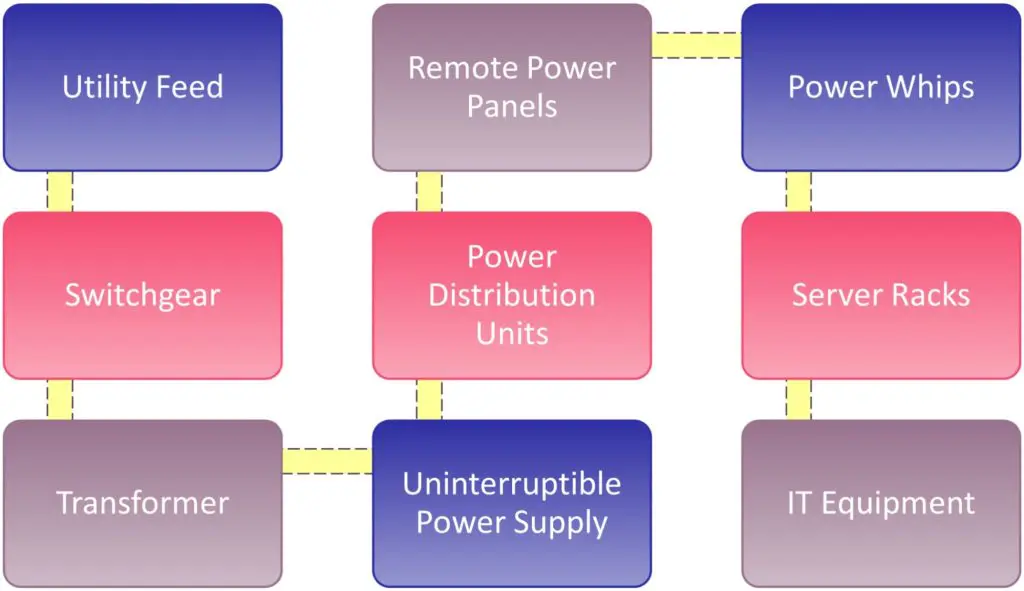Data center power systems are like the unsung heroes of data centers, quietly working behind the scenes to keep everything running smoothly. Without proper maintenance, though, they can quickly turn from reliable allies to major headaches. Keeping your power systems in check is essential for avoiding downtime, data loss, and costly disruptions.
As data centers continue to grow and handle more traffic, staying on top of power data center management is more important than ever. In this article, we’ll explore some simple, practical ways to keep your power systems running strong—whether you’re in charge of a large facility or a smaller one. Let’s dive in Danacloud articles and make sure your data center stays powered up and ready for anything!
How Power Flows in Data Centers
Power flows in data centers in a carefully orchestrated manner to ensure all equipment stays powered without interruptions. Here’s a simplified breakdown of how power flows:
Here’s a table summarizing how power flows in data centers:
| Stage | Description | Purpose |
|---|---|---|
| Electricity Supply | Power is sourced from the utility grid via high-voltage transmission lines. | Provides the initial source of electricity for the data center. |
| Utility Transformers | High-voltage power is stepped down to a lower voltage by transformers before entering the data center. | Ensures power is at a safe, usable voltage for the facility. |
| Uninterruptible Power Supply (UPS) | UPS systems maintain continuous power, providing a buffer during power transitions or outages. | Prevents power loss, ensuring no interruptions during power transitions. |
| Power Distribution Units (PDUs) | PDUs distribute regulated power to racks and servers while protecting against power surges. | Ensures stable and safe power delivery to equipment. |
| Backup Generators | Diesel or natural gas-powered backup generators provide power during extended outages. | Ensures uninterrupted operation during long-term power loss. |
| Redundancy | Multiple power feeds ensure that if one power source fails, others can take over. | Guarantees high availability and continuous operations. |
- Electricity Supply: Power comes from the utility grid, typically through high-voltage transmission lines. This electricity is converted into usable power for the data center.
- Utility Transformers: Before reaching the data center, the high-voltage power is stepped down to a lower voltage by utility transformers. This is necessary for safe operation within the facility.
- Uninterruptible Power Supply (UPS): Data centers use UPS systems to maintain a continuous power supply. The UPS acts as a buffer, ensuring no loss of power during transitions or outages.
- Power Distribution Units (PDUs): These devices distribute power across racks and servers. PDUs regulate the voltage, providing protection from power surges.
- Backup Generators: In case of extended power outages, backup generators powered by diesel or natural gas kick in. They ensure operations continue until the utility power is restored.
- Redundancy: Data centers often have multiple power feeds, ensuring a backup in case one fails. This redundancy is crucial to ensure high availability.
Efficient data center power systems are key for data centers to minimize downtime and ensure reliable service for critical business operations.
Reasons for Power Failure in Data Centers
Power failure can occur due to various reasons, disrupting operations and affecting business continuity. Understanding these causes helps in enhancing data center power systems to avoid outages:
- Utility Power Failures: Power grid issues, such as storms, accidents, or infrastructure failures, can cause interruptions. This is why data centers rely on UPS systems to bridge any gaps.
- UPS System Failure: A malfunction in the uninterruptible power supply (UPS) system can lead to sudden power loss, especially if the battery is outdated or not maintained properly.
- Generator Issues: Backup generators are essential for long outages, but mechanical failure, fuel shortages, or lack of routine maintenance can render them ineffective when needed.
- Overloaded Circuits: Data center power systems can face overloads when there’s an increase in demand or insufficient power management. This can cause circuit breakers to trip, halting power distribution.
- Cooling Failures: Cooling systems and power are interconnected. If a cooling failure overheats critical equipment, it can trigger automatic shutdowns or damage, resulting in a loss of power.
- Human Error: Incorrect configuration, poor maintenance, or failure to monitor power systems regularly can lead to unintentional failures in data center power systems.
How to Prevent Power System Failure in Data Centers?
Preventing power system failures in data centers is crucial to maintaining operational continuity and safeguarding sensitive data. A few proactive measures can significantly reduce the risk of power disruptions:
Here’s a table summarizing how to prevent power system failure in data centers:
| Preventive Measure | Description | Purpose/Benefit |
|---|---|---|
| Redundant Power Systems | Use backup systems such as UPS and diesel generators to ensure continuous power during grid failures. | Maintains power continuity during outages, minimizing downtime. |
| Regular Testing & Maintenance | Test and maintain backup systems through regular inspections, battery replacements, and cleaning. | Ensures backup systems function effectively in emergencies. |
| Power Equipment Monitoring | Perform preventive maintenance on key components like transformers, switches, and circuit breakers. | Reduces the likelihood of equipment failure, ensuring reliability. |
| Power Distribution Management | Balance load across circuits to avoid overloading any single component. | Prevents power overloads, ensuring stable distribution. |
| Smart Power Management Systems | Implement systems that detect anomalies, optimize energy use, and alert managers to potential risks. | Proactively identifies issues, optimizing energy usage and preventing failures. |
| Staff Training | Train personnel to quickly identify issues, mitigate risks, and ensure systems operate at peak performance. | Enhances response time and improves overall system management. |
First, implementing redundant power systems is key. This involves using backup systems, including uninterruptible power supplies (UPS) and diesel generators, which kick in when there’s a power failure from the main grid. Regular testing and maintenance of these systems ensure they work seamlessly in emergencies.
Next, monitoring and maintaining power equipment is essential. Preventive maintenance, including regular inspections, battery replacement, and cleaning, minimizes the chances of equipment failure. It’s also critical to keep an eye on the health of key components like transformers, switches, and circuit breakers.
Power distribution management plays a significant role as well. Balancing the load across circuits and avoiding overloading ensures that no single component is overwhelmed.
To further prevent power loss, data centers should adopt smart power management systems. These systems help in detecting anomalies, optimizing energy consumption, and alerting managers about potential risks before they turn into failures.
Lastly, staff training is vital. Well-trained personnel can quickly identify problems, mitigate risks, and ensure that data center power systems are operating at peak performance.
Power System Stability: Preparedness is Key
stability is critical for data centers to function efficiently without disruptions. Being prepared for power system failures ensures operational continuity and protects valuable data. Proactive steps such as implementing redundant power systems, performing regular maintenance, and utilizing smart power management solutions help ensure that data center power systems remain stable. Staff training also plays a key role in identifying potential issues before they escalate. By maintaining stability in power systems, data centers can avoid costly downtime and deliver reliable services, safeguarding the integrity of both their operations and their clients’ data. Preparedness truly is the key to success.
Conclusion
Maintaining reliable and stable power systems is crucial for data centers to function efficiently and ensure uninterrupted services. By understanding the importance of data center power systems, addressing potential failure causes, and implementing preventive measures, operators can safeguard against costly disruptions. Prioritizing preparedness, regular maintenance, and redundancy in power systems will help keep data centers operational, secure, and resilient. Ultimately, investing in robust power management ensures the longevity and reliability of a data center’s performance in an ever-evolving digital landscape.
FAQ
-
Why are UPS systems important for data centers?
UPS systems provide backup power in case of outages, preventing interruptions in service. They ensure that critical equipment continues running until generators kick in, protecting against data loss and maintaining smooth operations during power disruptions.
-
How often should data center power systems be tested?
Power systems should undergo regular testing, ideally every 6 to 12 months, to ensure all components function correctly. Routine checks, including battery health assessments, help identify issues before they lead to failures, ensuring smooth operations.
-
What are the risks of neglecting power system maintenance in a data center?
Neglecting power system maintenance can lead to unexpected failures, data loss, and downtime. It increases the risk of costly repairs, equipment damage, and disrupted services, negatively impacting customer trust and financial performance. Regular upkeep is essential to mitigate these risks.


